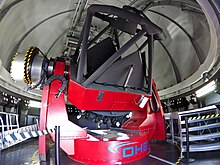Munich University Observatory
The Munich University Observatory (USM) in Bogenhausen is 6 km northeast of the city center and was founded in 1816 as the Royal Observatory . Since 1938 it has been part of the Institute for Astronomy and Astrophysics at Munich's Ludwig Maximilians University .
Because of the general increase in light pollution , observations on the outskirts are hardly possible today. They take place at two remote locations at the Wendelstein Solar Observatory (Upper Bavaria) and at Mount Fowlkes in Texas , where the new Hobby Eberly telescope (HET, oval 9 × 11 m mirror) was developed.
Today's research areas of the institute are mainly hot stars and stellar winds , cool stars, extragalactic astronomy , computational astronomy and plasma astrophysics .
history
On June 4, 1816 , King Max I Joseph gave the official order to build an observatory according to the requirements of the Bavarian Academy of Sciences on the higher bank of the Isar in the then independent village of Bogenhausen . On August 11, 1816, the groundbreaking ceremony for the Royal Observatory took place under the technical direction of the Royal Court Building Inspector Franz Thurn, and operations began in 1819. In 1938 the observatory was incorporated into the Faculty of Physics at the University of Munich .
Instruments

The USM has two branches: the solar observatory at the summit of Wendelstein in the Bavarian Alps and the Hobby-Eberly Telescope (HET) in Texas , a joint observatory with the University of Texas in Austin , Pennsylvania State University , and Stanford University in California and the Georg August University in Göttingen. The observatory is located in the Davis Mountains about 700 km west of Austin.
Wendelstein Observatory
In 1987, an 80 cm telescope was put into operation, which had to give way to construction work for a new 2 meter telescope. A 40 cm Cassegrain telescope was procured as a replacement , which will be used until the new instrument is completed. It is equipped with an SBIG CCD camera and filters especially for the optical sector. The focal length is 3.2 m, which gives a ratio of f / 8.
A 20 cm coronograph (specially manufactured by Zeiss) is used for solar observation . It allows the sun to be observed in white light, in the red Hα line and in the color spectrum. In favorable weather conditions the solar atmosphere can be examined with the use of screens (artificial solar eclipse).
Furthermore, until 2008 a meteorite camera was operated for the DLR (German Aerospace Center) as part of the monitoring network.
At the end of 2013, the new 2-meter Fraunhofer telescope went into operation at Wendelstein . It was named after the German optician and physicist Joseph Fraunhofer .
Hobby Eberly Telescope

± 4 × 10 −4 s / day. The most precise mechanical watch to date.
The new 9 or 11 meter telescope with a focal length of 13.1 meters consists of 91 Zerodur mirror elements. Several instruments are available for observation in the optical and near infrared as well as for spectrographic recordings.
literature
- Freddy Litten: Astronomy in Bavaria 1914–1945. Steiner, Stuttgart 1992, pp. 43-87, 137-153
Web links
Coordinates: 48 ° 8 ′ 43 ″ N , 11 ° 36 ′ 25 ″ E


